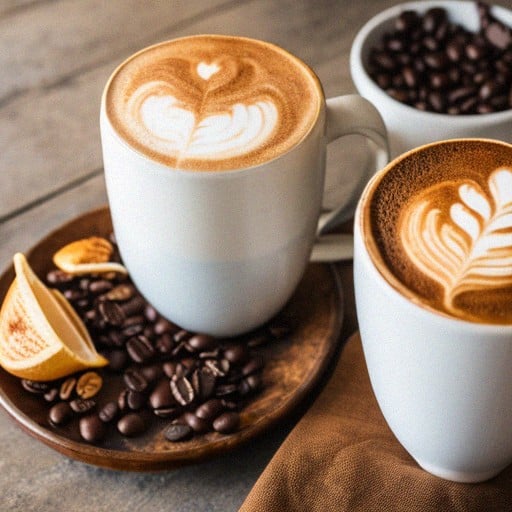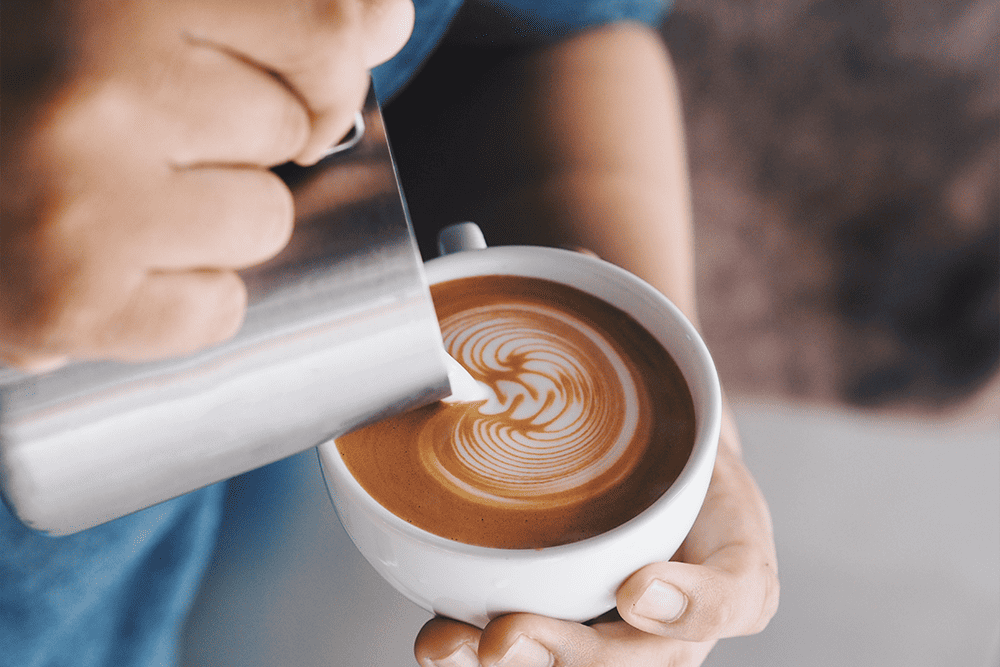Latte vs Cappuccino: Understanding the Key Differences

A latte and a cappuccino are two of the most popular espresso-based drinks in the world. Both are made with espresso and milk, but they differ in their texture and the ratio of ingredients used. While some people use these terms interchangeably, there are some key differences between a latte and a cappuccino that are worth noting.
A latte is a coffee drink that is made with espresso, steamed milk, and a thin layer of foam on top. The ratio of ingredients in a latte is typically one-third espresso, two-thirds steamed milk, and a small amount of foam. On the other hand, a cappuccino is made with equal parts espresso, steamed milk, and foam. The foam in a cappuccino is typically thicker and more velvety than the foam in a latte, which gives the drink a creamier texture.
Understanding Espresso
Espresso is a concentrated coffee beverage that is brewed by forcing hot water through finely ground coffee beans at high pressure. It is the base ingredient for many popular coffee drinks, including lattes and cappuccinos.
A shot of espresso is typically 1 ounce in volume, and is made by using 7-8 grams of coffee grounds. The resulting shot should have a rich, creamy layer of crema on top, which is formed by the emulsification of oils in the coffee beans.
To make espresso, a barista uses an espresso machine, which is specifically designed to brew espresso by forcing hot water through the coffee grounds. Espresso machines come in many different varieties, from manual lever machines to fully automatic machines that can make multiple espresso shots at once.
Espresso shots are the building blocks for many espresso drinks, including lattes and cappuccinos. A latte is made by combining a shot of espresso with steamed milk, while a cappuccino is made by combining a shot of espresso with equal parts steamed milk and milk foam.
Many coffee shops offer the option of getting two shots of espresso in your drink, which is sometimes referred to as a “double shot.” This can add extra strength and flavor to your latte or cappuccino.
Overall, understanding espresso is key to understanding the world of espresso drinks. Whether you prefer a simple shot of espresso or a more complex latte or cappuccino, knowing the basics of how espresso is made and how it is used in different drinks can help you make informed choices and enjoy your coffee to the fullest.

Latte Basics
If you’re a coffee lover, you’ve probably heard of lattes. A latte is an espresso-based drink that’s made with steamed milk and a small amount of foam. It’s a smooth and creamy drink that’s perfect for any time of day.
The ingredients used to make a latte are simple – espresso, steamed milk, and a small amount of foam. The ratio of these ingredients can vary depending on personal preference, but a typical latte is made with one shot of espresso and about 8-12 ounces of steamed milk.
One of the things that sets a latte apart from other espresso-based drinks is its texture. The steamed milk gives the latte a smooth and creamy texture that’s hard to resist. In fact, many people enjoy lattes for their texture as much as for their taste.
Latte art has become increasingly popular over the years, especially in Australia and New Zealand. Skilled baristas can create intricate designs in the foam on top of a latte, adding a touch of beauty to an already delicious drink.
In some countries, a latte is called a café latte or caffè latte. In others, such as Australia and New Zealand, a latte is typically served in a glass and is called a latte macchiato. Regardless of what it’s called, a latte is a delicious and satisfying drink that’s perfect for any coffee lover.

Cappuccino Essentials
Cappuccino is a popular Italian espresso-based drink that is enjoyed all over the world. It is made from a shot of espresso, steamed milk, and milk foam. The drink is named after the Capuchin monks, who wore brown hoods that resembled the color of the coffee when mixed with milk.
One of the essential elements of a cappuccino is its ratio of espresso to steamed milk to milk foam. A cappuccino has a specific weight ratio of 1:1:1, which means that each of the three components should be equal in volume. The espresso provides the rich, bold flavor, while the steamed milk adds a creamy texture to the drink. The milk foam, which is made by frothing milk with air, creates a light and airy foam that sits on top of the drink.
The texture of a cappuccino is also an essential aspect of the drink. The milk foam should be light and airy, with small bubbles that create a velvety texture. The steamed milk should be smooth and creamy, with a rich and velvety texture that complements the boldness of the espresso.
When making a cappuccino, the milk foam is added last, sitting on top of the steamed milk and espresso. The foam should be light enough to float on top of the drink without sinking or mixing with the other components.
Overall, cappuccinos are known for their rich and creamy texture, with a light and airy foam that sits on top of the drink. The specific weight ratio of the drink ensures that each component is balanced, creating a harmonious blend of flavors and textures.
Comparing Taste and Flavor
When it comes to taste and flavor, latte and cappuccino have distinct differences.
Latte
Lattes are known for their sweet and subtle flavors. The espresso in a latte is combined with steamed milk and a small amount of foam. This results in a creamy and smooth texture that is less intense than a cappuccino. Lattes also tend to have a stronger coffee flavor than cappuccinos due to the higher milk to espresso ratio.
Cappuccino
Cappuccinos, on the other hand, have a stronger coffee flavor due to their higher espresso to milk ratio. The foam in a cappuccino is also denser and thicker than a latte, resulting in a more intense and bold flavor. The texture of a cappuccino is also drier and less creamy than a latte.
Overall, the taste and flavor of latte and cappuccino come down to personal preference. If you prefer a sweeter and creamier drink, a latte may be your go-to. If you enjoy a stronger and bolder coffee flavor, a cappuccino may be more up your alley.
Textural Differences
When it comes to textural differences, the cappuccino and latte have distinct characteristics. The texture of a cappuccino is smooth and creamy, with a thick layer of microfoam on top. This microfoam is created by steaming milk, which is then poured over a shot of espresso. The foam is thicker than that of a latte, giving the cappuccino a more velvety mouthfeel.
On the other hand, a latte has a thinner layer of foam, with a more milky and less creamy texture. The milk is steamed and poured over the espresso shot, creating a layer of microfoam that is less dense than that of a cappuccino. The result is a smoother and more delicate mouthfeel.
The difference in texture between a cappuccino and latte comes down to the amount of milk and foam used in each drink. A cappuccino typically has equal parts espresso, steamed milk, and foam, while a latte has more steamed milk and less foam. This makes the cappuccino denser and creamier, while the latte is lighter and more delicate.
In summary, the textural differences between a cappuccino and latte are significant. The cappuccino has a smooth and creamy texture with a thick layer of microfoam, while the latte has a thinner layer of foam and a more milky texture. The difference in texture is due to the amount of milk and foam used in each drink, with the cappuccino having equal parts espresso, steamed milk, and foam, and the latte having more steamed milk and less foam.
Ingredients and Ratios
Both latte and cappuccino are espresso-based drinks that are made with the same ingredients: espresso shot, milk, and foam. However, the ratios of these ingredients differ between the two drinks, resulting in different taste and texture.
A cappuccino is made with a shot of espresso, a small amount of steamed milk, and a thick layer of milk foam on top. The ratio of espresso to milk in a cappuccino is typically 1:1, with the milk foam accounting for about one-third of the drink. The milk foam layer is about a finger width and is often dusted with cocoa powder.
On the other hand, a latte is made with a shot of espresso and a larger amount of steamed milk. The ratio of espresso to milk in a latte is typically 1:3 to 1:5, with the steamed milk accounting for the majority of the drink. A latte has a thin layer of foam on top, which is created by pouring the steamed milk into the espresso shot.
The table below summarizes the ingredients and ratios of a cappuccino and a latte:
| Drink | Ingredients | Espresso Shot | Milk | Foam |
|---|---|---|---|---|
| Cappuccino | Espresso, Steamed Milk, Milk Foam | 1 | 1/3 | 1/3 |
| Latte | Espresso, Steamed Milk, Milk Foam | 1 | 3-5 | Thin Layer |
It is worth noting that the size of the drink can also affect the ratios of the ingredients. Bigger drinks have a higher proportion of milk, while smaller drinks have a higher proportion of espresso.
In terms of taste, a cappuccino has a stronger espresso flavor and a thicker, creamier texture due to the higher proportion of milk foam. A latte, on the other hand, has a milder espresso flavor and a smoother, silkier texture due to the higher proportion of steamed milk.
Variations and Adaptations
While the traditional latte and cappuccino have their own unique characteristics, variations and adaptations have been made to cater to different preferences and tastes. Here are some of the most popular variations:
- Iced Latte: A refreshing twist on the classic latte, an iced latte is made with chilled milk and espresso poured over ice. It’s perfect for hot summer days or as a mid-day pick-me-up.
- Flat White: Originating from Australia and New Zealand, a flat white is made with a double shot of espresso and steamed milk, but with less foam than a traditional cappuccino. It has a velvety texture and a strong coffee taste.
- Mocha: A delicious combination of espresso, steamed milk, and chocolate syrup or powder, a mocha is perfect for those who love a sweet and creamy coffee drink.
- Latte Macchiato: A latte macchiato is made by pouring steamed milk into a glass, followed by a shot of espresso. The milk and espresso do not mix, creating a layered effect. It’s a great option for those who prefer a stronger coffee taste.
- Macchiato: A macchiato is an espresso shot with a small amount of milk foam on top. It’s a great option for those who prefer a stronger coffee taste but still want a little bit of milk.
- Iced Cappuccino: Similar to an iced latte, an iced cappuccino is made with chilled milk and espresso poured over ice, but with a little bit of foam on top. It’s a great option for those who want a stronger coffee taste but still want a little bit of milk.
- Brewed Coffee: For those who prefer a simpler coffee drink, brewed coffee is a great option. It’s made by pouring hot water over ground coffee beans and can be enjoyed black or with a splash of milk.
It’s important to note that while these variations and adaptations may differ in their ingredients and preparation methods, they all still have the same base of espresso and milk.
Nutritional Aspects
When it comes to the nutritional aspects of lattes and cappuccinos, there are a few differences to consider. Both drinks are made with espresso and milk, but the ratios of these ingredients vary between the two.
Calories
Generally speaking, lattes tend to have more calories than cappuccinos due to their higher milk content. A 12-ounce latte made with whole milk can contain around 210 calories, while a 12-ounce cappuccino made with whole milk has around 130 calories [1]. However, the calorie count can vary depending on the type of milk used and any additional flavorings or sweeteners added.
Fat and Sugars
Since lattes contain more milk than cappuccinos, they also tend to have more fat and sugars. A 12-ounce latte made with whole milk can contain around 7 grams of fat and 12 grams of sugar, while a 12-ounce cappuccino made with whole milk has around 4 grams of fat and 5 grams of sugar [2].
Protein
Both lattes and cappuccinos contain some protein, but the amount is relatively small. A 12-ounce latte made with whole milk contains around 8 grams of protein, while a 12-ounce cappuccino made with whole milk contains around 6 grams of protein [3].
Specific Weight
In terms of specific weight, cappuccinos are generally considered to be lighter than lattes due to their higher foam content. This can make them a good choice for those who are watching their weight or trying to limit their calorie intake.
Overall, while lattes and cappuccinos may seem similar, there are some key nutritional differences to consider. If you’re looking for a lower calorie option, a cappuccino may be a better choice. However, if you’re looking for a creamier, sweeter drink, a latte may be more your style.
Art of Barista
When it comes to the difference between a latte and a cappuccino, the Art of Barista website provides a clear and concise explanation. According to their article, both lattes and cappuccinos are made with the same basic ingredients: espresso, foam, and steamed milk. However, the difference lies in how these ingredients are combined.
A latte typically has more steamed milk and a thin layer of foam on top, while a cappuccino has equal parts of espresso, steamed milk, and foam. This means that a cappuccino will have a thicker layer of foam on top than a latte.
The Art of Barista also emphasizes the importance of barista craft in creating the perfect latte or cappuccino. This includes the proper preparation of espresso, steaming of milk, and pouring technique to create latte art.
For coffee shop owners and baristas, mastering the art of latte and cappuccino preparation can be a key factor in attracting and retaining customers. With the rise of social media platforms like Instagram, the presentation of coffee drinks has become just as important as the taste.
Overall, the Art of Barista provides a helpful guide for understanding the difference between a latte and a cappuccino, as well as the importance of barista craft in creating the perfect coffee drink.
Cultural Influence
The cultural influence of these two popular coffee drinks is undeniable. While both latte and cappuccino originated in Italy, they have been adapted and modified in various parts of the world to suit local tastes and preferences.
In Italy, cappuccino is traditionally consumed only in the morning, whereas latte is enjoyed throughout the day. Cappuccino is also typically served in smaller portions compared to latte. The Italian way of making cappuccino involves a specific ratio of espresso to steamed milk to milk foam, which is different from the way latte is made.
In Australia and New Zealand, the flat white has become a popular alternative to both latte and cappuccino. It is similar to a latte, but with less milk and more espresso, resulting in a stronger coffee flavor. The flat white is often served in a smaller cup compared to latte and cappuccino.
Interestingly, the name cappuccino is derived from the Capuchin monks, who wore brown hoods that resembled the color of the coffee drink. However, the drink itself has no direct connection to the monks or their practices.
In conclusion, while the origins of latte and cappuccino may be traced back to Italy, their cultural influence has spread far and wide. From the flat white in Australia and New Zealand to the history of the Capuchin monks, the evolution of these drinks is a testament to the adaptability and creativity of coffee culture around the world.
Frequently Asked Questions
What is the difference in milk texture between a latte and a cappuccino?
The main difference in milk texture between a latte and a cappuccino is the amount of microfoam. A latte has a smooth and creamy texture due to the steamed milk being mixed with a small amount of microfoam. In contrast, a cappuccino has a drier texture because it is made with more microfoam, which creates a thicker and airier layer of foam on top of the steamed milk.
How does the ratio of espresso to milk differ between a latte and a cappuccino?
The ratio of espresso to milk is different between a latte and a cappuccino. A latte contains more milk than a cappuccino, so the espresso flavor is more diluted. A cappuccino, on the other hand, has a stronger espresso flavor because it contains less milk.
What is the difference in foam consistency between a latte and a cappuccino?
The foam consistency is different between a latte and a cappuccino. A latte has a thin layer of microfoam on top of the steamed milk, which creates a smooth and creamy texture. A cappuccino, on the other hand, has a thick and airy layer of microfoam on top of the steamed milk, which creates a drier texture.
Which drink typically has more milk, a latte or a cappuccino?
A latte typically has more milk than a cappuccino. A latte is made with steamed milk and a small amount of microfoam, while a cappuccino is made with equal parts of steamed milk, microfoam, and espresso.
Do lattes and cappuccinos have the same amount of caffeine?
No, lattes and cappuccinos do not have the same amount of caffeine. A cappuccino has a higher concentration of espresso, which means it has more caffeine than a latte.
What is the difference in taste between a latte and a cappuccino?
The taste difference between a latte and a cappuccino is due to the ratio of espresso to milk. A latte has a milder espresso flavor because it contains more steamed milk, while a cappuccino has a stronger espresso flavor because it contains less milk. The texture of the foam also affects the taste, with a latte having a creamier texture and a cappuccino having a drier texture.






One Comment